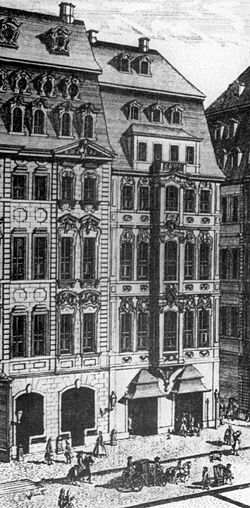
Cleveland Orchestra to Go Clubbing With Chamber Music
A contemporary drawing of Zimmerman’s Coffee House in Leipzig.
This is the time of year when almost any gathering of people anywhere turns festive: offices become temporary holiday kitchens, customers in coffee shops extend the best wishes of the season to each other, shoppers share tips as they pick over the last items in a denuded store aisle.
That sense of celebration is often accompanied by music, of course; the sounds of the season, commercial and sacred, are almost inescapable. But the playing of music itself at any time of year is often cause for conviviality if not outright celebration, and next month, the Cleveland Orchestra will recognize that when it hosts an evening of nosh and chamber music after an abbreviated concert Jan. 28.
The Clevelanders announced earlier this month that they would be adding another concert to their second series of shows at the Knight Concert Hall, this one an intermission-less evening with a coda in which patrons will retire to the Carnival Studio at the Arsht Center for a post-concert evening of chamber music, “libations and upscale snacks,” as the orchestra’s PR people put it. (Back home in Ohio, the orchestra does this in its Fridays@7 series.)
Classical music is no stranger to accompanying social functions, it need hardly be said. The market for serenades to serve as high-end background music during the 18th century in particular was a robust one, and composers including Mozart, Haydn and Beethoven supplied the need. In an earlier era, J.S. Bach wrote for the regular weekly concerts at Zimmerman’s Coffee House in Leipzig, including the secular vocal work we now know as the Coffee Cantata.
Then, too, there are the intermission snacks and drinks available at most venues during classical concerts, some of which no doubt help the music go down easier for less committed patrons. So pairing the two in a club-style setting makes a lot of logical sense.
There has been a trend in recent years to bring classical back to the clubs and more prosaic commercial establishments, instead of just confining it to one concert hall or another. Young instrumentalists such as cellist Matt Haimovitz have played in all sorts of clubs and restaurants, and on New York’s Bleecker Street, the club Le Poisson Rouge routinely offers classical events along with its other, very different, fare (the violinist Hilary Hahn, for instance, is hosting a “Bach party” there Jan. 12).
I think all of this is just fine, really: this music is durable enough to withstand any sort of performance, no matter how unusual, and it does offer the opportunity for new ears to hear what all the centuries-long fuss has been about. People are always up for entertainment, and if you give them an avenue to it that also caters to their sense of fun, food and sociability, you’re not betraying the music in any way.
One hopes, though, that some of the people who come to the Knight for the all-Beethoven concert — the Fifth Symphony, Leonore No. 3, and the Romance No. 2, with concertmaster William Preucil — and then stick around for the 9 p.m. club event with chamber music will hear something new they like and decide it’s worth further exploration.
After all, at some point you have to mute the distractions and let the music speak all by itself, and you may discover that it does just as well on its own as it does accompanied by petit-fours, chocolate martinis and that divine spinach dip.